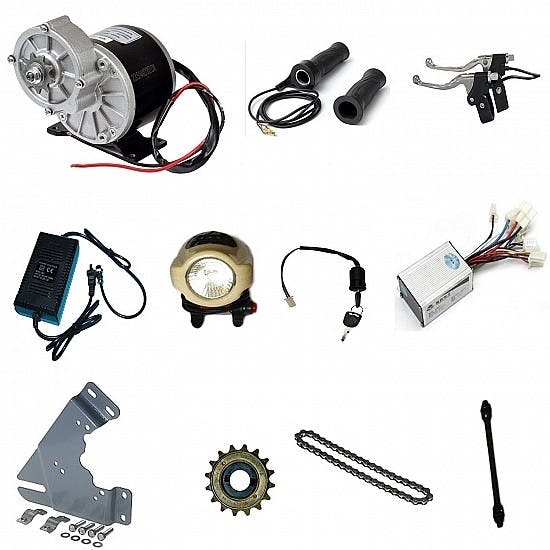Introduction:
In the wake of growing interest in electric cars, the notion of electrifying the traditional mode of transport has attracted a lot of interest. One of the innovations that have attracted the interest of many cyclists is to convert a bicycle into an electric one. With the help of an electric motor and batteries, you'll get a better enjoyment of cycling, increase your travel distance, and tackle difficult surfaces with ease. In this article, we'll explore the possibility of turning your bike into an electric bicycle by providing the necessary components and steps.
1. Understanding the components Before you begin your journey of converting to an electric bike, It is essential to become well-versed in the elements that make up the electric bike, which includes:
A) An electric Motor: The heart of an electric bike. The motor is the source of power for you to pedal. Motors are generally mounted on the front or rear wheel hubs or integrated into the bike's bottom bracket.
B) Battery: The power source for the electric motor. The battery is usually mounted on the bike's frame. The capacity and power of the battery decide the efficiency and power of the electric bicycle.
C) Controller This controller acts as the brains for the bike. It controls the transfer of power from the motor to the battery. It lets you choose the degree of assistance and offers many individualization options.
D) Sensors or the Sensor or Pedal Assist System (PAS): The PAS detects the movement of your pedal and calculates the level of help required to get from your motor. It enables an unbreakable connection between your pedal movements and the motor's assistance.
- For your bicycle to be converted into an electric bicycle, You'll require the converter kit comprising the elements listed below. Kits for conversion are readily offered on the market and are available in various options that can accommodate various types of bikes and personal tastes. Before deciding on a particular option, you should consider compatibility with your frame bicycle, the strength of the motor, the battery range, and the overall quality. You should research different brands and read the reviews by customers so that you can make an informed decision.

3. The Installation Procedure: When you've acquired your conversion kit, install it on the bicycle. Although the procedure for installing will differ based on the specific kit you purchased as well as the design of your bicycle, These are the tips to guide you:
A) Removing your bike's front or rear wheel depending on where the motor is installed.
B) Install the motor onto the wheel's hub, then fix it as per the guidelines included in the kit. Check that the power cables for your motor are correctly positioned.
C) Place the battery onto the frame of your bicycle. Ensure it's secure and aligned correctly to ensure your bike's balance when riding.
D) Connect the motor, battery and controller using the supplied wiring harnesses and follow the instructions on the kit. Check all connections to make sure you're safe and secure.
(e.g.) Install the PAS sensor, which detects and relays your pedal motion to your control. The sensor's position should be adjusted to meet what the kit recommends.
F) Examine the performance of the new electric bike by turning on the motor while pedalling gently. Know the different help levels and make sure that the motor is engaged and disengages quickly.
4. Security considerations: When you switch your bicycle to an electric bike, you must consider security. Here are some tips for safety to remember:
A) Use a helmet and other protective gear while riding the electric bike.
B) Be aware of traffic regulations and laws like every other car.
C) Keep an eye on and regularly inspect your electronic bike, paying particular focus on the battery, motor,
The transformation of a conventional bicycle to an electric model is becoming a popular selection among those who are avid cyclists. Through the addition of batteries as well as the electric motor, cyclists can enhance their riding as well as benefit from electronic aid. Here are some most important facts about how many riders are turning their bicycles into electric bikes:
It is easy and economical that changing the bike into an electric bicycle is much more affordable than buying an electric bike completely new. There are many bicycles that they are at ease with. The conversion to an electric bike could allow users to enjoy electric bikes without spending much.
Modifying bicycles allows users to alter the bike according to their needs and preferences. Conversion kits offer various choices that are customizable, which means that users can create an electric bicycle which is ideal for the style of their riding and their needs.
Green transportation: Electronic bicycles such as modified e-bikes are green and sustainable modes of transport. By converting their bicycles, cyclists can help to reduce carbon dioxide while encouraging sustainable travel. Indeed is an excellent option for people who require the power of electric motors but want to keep their bikes.
DIY enthusiasts: Many people are intrigued by the thought that they can convert their bicycles into electric bikes by completing DIY (DIY) projects. You can gain knowledge about diverse components, knowledge in the field, and a better understanding of the technology that e-bikes use. DIY conversion kits come with extensive instructions. It is, therefore, accessible to anyone proficient in mechanics.
Greater range and flexibility: An electric motor added to a bicycle can increase its capability and capacity. Commuters can effortlessly traverse difficult surfaces and cover greater distances while exerting less exertion. Electronic assistance lets riders move quickly, easily and easily, making electric bikes a great alternative to conventional bikes to commute daily.
Retrofitting bicycles from the past: Making older bicycles electric bikes can provide owners with new leases. People who have a connection to their bicycles or have the aesthetic appeal of the particular model can maintain their preferred bike while benefitting from the benefits of electronic aid. Additionally, it helps reduce the volume of garbage created by recycling the bikes already utilized instead of discarding them.
The growing number of people interested in conversions to E-bikes has created an online community of DIY enthusiasts who share their experiences through advice, tricks and ideas. Forums, Facebook forums, and dedicated websites enable individuals to get together, share experiences, and seek assistance during conversion. The feeling of community support from the public has also pushed users to turn their bikes into electric bikes.
The conclusion: Conversion of a bicycle into an electric model provides many benefits, like affordability, customization and environment. Using DIY conversion kits online, users can convert their bicycles into environmentally friendly and reliable electric bikes. The rising popularity of electric bicycles can reflect the enthusiasm and innovation of the cycling sector and shows the evolving possibilities of the transportation industry towards a green future.

